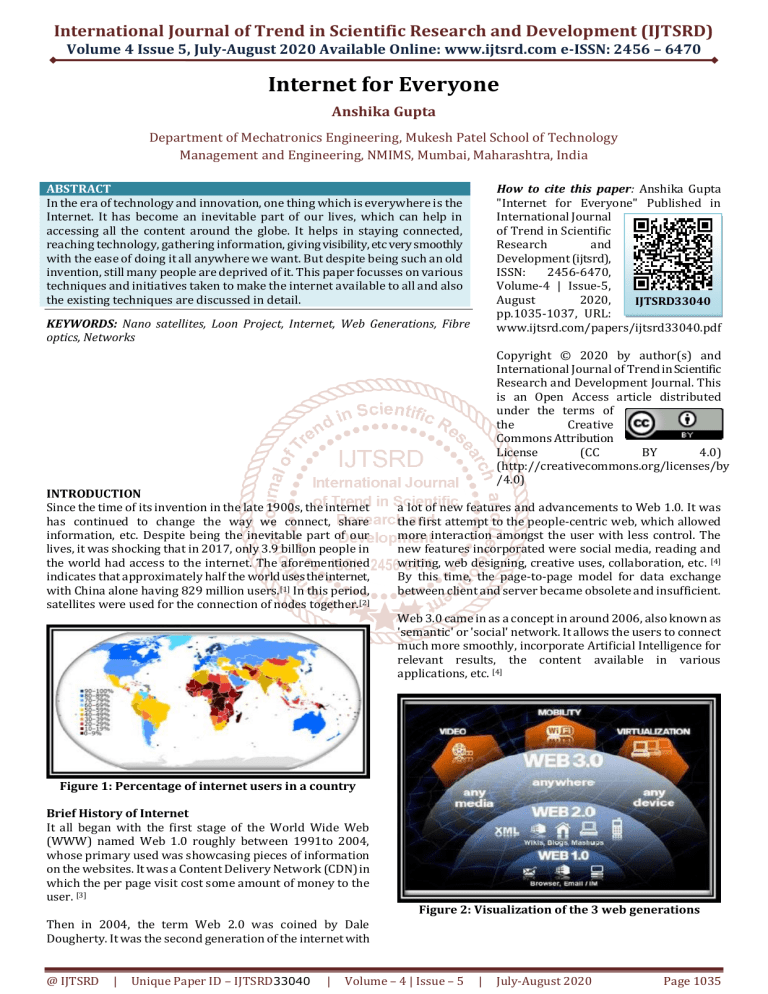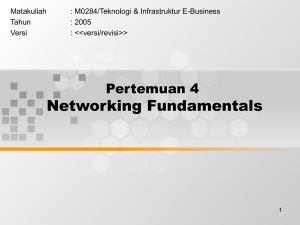
International Journal of Trend in Scientific Research and Development (IJTSRD) Volume 4 Issue 5, July-August 2020 Available Online: www.ijtsrd.com e-ISSN: 2456 – 6470 Internet for Everyone Anshika Gupta Department of Mechatronics Engineering, Mukesh Patel School of Technology Management and Engineering, NMIMS, Mumbai, Maharashtra, India ABSTRACT In the era of technology and innovation, one thing which is everywhere is the Internet. It has become an inevitable part of our lives, which can help in accessing all the content around the globe. It helps in staying connected, reaching technology, gathering information, giving visibility, etc very smoothly with the ease of doing it all anywhere we want. But despite being such an old invention, still many people are deprived of it. This paper focusses on various techniques and initiatives taken to make the internet available to all and also the existing techniques are discussed in detail. How to cite this paper: Anshika Gupta "Internet for Everyone" Published in International Journal of Trend in Scientific Research and Development (ijtsrd), ISSN: 2456-6470, Volume-4 | Issue-5, August 2020, IJTSRD33040 pp.1035-1037, URL: www.ijtsrd.com/papers/ijtsrd33040.pdf KEYWORDS: Nano satellites, Loon Project, Internet, Web Generations, Fibre optics, Networks INTRODUCTION Since the time of its invention in the late 1900s, the internet has continued to change the way we connect, share information, etc. Despite being the inevitable part of our lives, it was shocking that in 2017, only 3.9 billion people in the world had access to the internet. The aforementioned indicates that approximately half the world uses the internet, with China alone having 829 million users.[1] In this period, satellites were used for the connection of nodes together.[2] Copyright © 2020 by author(s) and International Journal of Trend in Scientific Research and Development Journal. This is an Open Access article distributed under the terms of the Creative Commons Attribution License (CC BY 4.0) (http://creativecommons.org/licenses/by /4.0) a lot of new features and advancements to Web 1.0. It was the first attempt to the people-centric web, which allowed more interaction amongst the user with less control. The new features incorporated were social media, reading and writing, web designing, creative uses, collaboration, etc. [4] By this time, the page-to-page model for data exchange between client and server became obsolete and insufficient. Web 3.0 came in as a concept in around 2006, also known as 'semantic' or 'social' network. It allows the users to connect much more smoothly, incorporate Artificial Intelligence for relevant results, the content available in various applications, etc. [4] Figure 1: Percentage of internet users in a country Brief History of Internet It all began with the first stage of the World Wide Web (WWW) named Web 1.0 roughly between 1991to 2004, whose primary used was showcasing pieces of information on the websites. It was a Content Delivery Network (CDN) in which the per page visit cost some amount of money to the user. [3] Figure 2: Visualization of the 3 web generations Then in 2004, the term Web 2.0 was coined by Dale Dougherty. It was the second generation of the internet with @ IJTSRD | Unique Paper ID – IJTSRD33040 | Volume – 4 | Issue – 5 | July-August 2020 Page 1035 International Journal of Trend in Scientific Research and Development (IJTSRD) @ www.ijtsrd.com eISSN: 2456-6470 In 2009, again the inventor of web 3.0 coined the term web 4.0, in a TED talk. It is the era of the Internet of Things, in which the traditional appliances begin to become smart by using the internet for doing the needful on their own without human dependence or assisting in a task.[5] The cables Some significant ways to provide the internet are by using cables, typically coaxial, but nowadays, a new technology of using fibre optic cables has been trending. The two types of cables are defined: In the above ways, the internet is continuously developing and performs a vital role in our lives today, so its access is becoming imperative. After observing that millions of people still do not have access to the internet, then many companies stepped forward to find a solution to this problem. The major problems that provided hindrance in accessing internet constituted of infrastructure, affordability, incentives, user capability, etc. These problems were accounted and the following infrastructure were incorporated along with other initiatives that were proving to be innovative in providing a solution. Coaxial cable or coax cable transmits radio frequency signals from one place to another through magnetic fields generated in the conducting parts. It consists of four layers 1. Centre Core: This is the central conducting part made of copper. In this layer, the signal travels by conducting using magnetic fields. 2. Dielectric Insulator: This is the layer that is usually made of plastic which acts as a jacket to provide an insulation. 3. Metallic shield: It is like a mesh structure used to reduce Electromagnetic Interference to avoid disturbances in the transmitted signal. 4. Plastic Jacket: This is the outermost layer made of plastic that protects the inner layers. The Satellite Chronology The satellites have been old contributors in the field of wireless internet. At first, the internet did not rely on satellites, instead operated on packet switching on multiple paths and nodes. Then after they were united, faced many issues like cost, optimization, and performance. [6] Later many improvements led to enhance technology and make it efficient. The satellite types that mainly attracted the internet companies are given in table1. Satellite Type Distance from Earth Geostationary orbit 35,785 Km Feature Its RTT is approximately 250ms. RTT latency is about Medium Earth 10,000 Km to 125ms, throughput of orbits 20,000 Km. about 1Gb/sec. Highly 1,000 Km to Not used due to high Elliptical orbit 39,360 Km signal lag time. The RTT is about Low Earth Below 40ms, throughput of orbits 1000Km about 64 bits/sec. Table 1: Satellite Types used for Internet provision with their distances from Earth’s surface. [7] From the above comparison it is clear that mostly low Earth orbits satellites are used to provide the internet connection due to low RTD, meaning faster transmission. Figure 4: Diagram of Coaxial Cable Fibre Optic Cables consist of multiple small strands of glass or plastic, in which the signal propagates in the form of light. It works on the principle of Total Internal Reflection. It consists of two layers, that are: 1. The Core: It is the inner part of the cable in which the signal propagates in the form of light. 2. Cladding: It is the layer of glass that surrounds the core and has a lower refractive index than the core. Figure 5: Diagram of Fibre Optic Cable Figure 3: Different satellites with orbit path @ IJTSRD | Unique Paper ID – IJTSRD33040 | Volume – 4 | Issue – 5 | July-August 2020 Page 1036 International Journal of Trend in Scientific Research and Development (IJTSRD) @ www.ijtsrd.com eISSN: 2456-6470 Features Coaxial Fibre Optic Transmission Magnetic fields Reflection of Medium and conduction light Cost Relatively cheap Expensive External Affected Not affected Magnetic Field Installation Easy Difficult Bandwidth <1GHz <10GHz Table 2: Difference between Coaxial and Fibre Optic Cables The above table shows the comparison and can assist in choosing that which is the better to choose in terms of effective transmission and feasible. The Loon Project The project Loon was an initiative taken by Google to bring on the internet for all. It consisted of launching balloons in the stratosphere, having 18 to 25 km high altitude, for creating the wireless signal of speed 1 Mbps/min. The inflation of balloons was with helium and a course of 2 years with reusability. It consisted of the following 3 elements: 1. The Envelope: It was the balloon that was 12m high and 15m wide, made of polyethylene plastic material which was UV resistant and high-temperature resistance. 2. The Solar Panels: This is the energy generator of the system with an average of 100W/day. It is built from a flexible plastic laminate, consists of monocrystalline solar cells. 3. Electronics: It consists of sensors and other electronic components like GPS tracker, radio antenna, etc. [9] estimated to fly through the equator twice and poles 16 times. The connection will just require to install a modem that is cheaper than the local internet services and can last upto 10 years. This concept is still under development and has a lot of potential. Conclusion Internet is a huge pats of our lives and is necessary for accessing important information, anytime, anywhere. Making it available for all is a huge challenge, but many technologies have been developed and are still being researched on to make it more cost effective and feasible. In this paper the most popular techniques of propogation were discussed along with the evolution of web. These projects are gaining momentum rapidly and are being funded by a lot of big companies. These methods can be made more efficient and their might be a posibillity that internet may be access able to all. References [1] https://www.statista.com/topics/1145/internetusage-worldwide/ [2] J. Takei and J. Murai, "Satellite communication on the Internet: its history and the technology," 2003 Symposium on Applications and the Internet Workshops, 2003. Proceedings., Orlando, FL, USA, 2003, pp. 3-7, doi:10.1109/SAINTW.2003.1210116. [3] https://www.geeksforgeeks.org/web-1-0-web-2-0and-web-3-0-with-their-difference/ [4] K. Nath, S. Dhar and S. Basishtha, "Web 1.0 to Web 3.0 Evolution of the Web and its various challenges," 2014 International Conference on Reliability Optimization and Information Technology (ICROIT), Faridabad, 2014, pp. 86-89, doi: 10.1109/ICROIT.2014.6798297. [5] Nupur Choudhury,” World Wide Web and Its Journey from Web 1.0 to Web 4.0” (IJCSIT) International Journal of Computer Science and Information Technologies, Vol. 5 (6) , 2014, 8096-8100. [6] L. Caviglione, "Can satellites face trends? The case of Web 2.0," 2009 International Workshop on Satellite and Space Communications, Tuscany, 2009, pp. 446450, doi: 10.1109/IWSSC.2009.5286305. [7] W. W. Wu, "Internet Satellite Challenges," 2010 2nd International Conference on Evolving Internet, Valcencia, 2010, pp. 31-35, doi: 10.1109/INTERNET.2010.15. Figure 6: Representation of working of loon All the ballons are in sync with others within 30 miles using a radio transceiver. The ballons also connects with antennas on the ground using a second transceiver, almost giving a speed equivalent to 3G and aiming it to be near to LTE. Micro/ Nano Satellites the future They are artificial satellites very small in size usually ranging between 20 to 100kgs, are sent to the stratosphere and can be used to provide internet to the areas that do not have any trace of internet till now or have very low speed. They are @ IJTSRD | Unique Paper ID – IJTSRD33040 | [8] J. R. Kiniry and C. Metz, "Cable modems: cable TV delivers the Internet," in IEEE Internet Computing, vol. 2, no. 3, pp. 12-15, May-June 1998, doi: 10.1109/4236.683789. [9] L. Nagpal and K. Samdani, "Project Loon: Innovating the connectivity worldwide," 2017 2nd IEEE International Conference on Recent Trends in Electronics, Information & Communication Technology (RTEICT), Bangalore, 2017, pp. 1778-1784, doi: 10.1109/RTEICT.2017.8256905. Volume – 4 | Issue – 5 | July-August 2020 Page 1037

